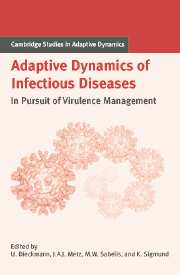Book contents
- Frontmatter
- Contents
- Contributing Authors
- List of Boxes
- Notational Standards
- 1 Introduction
- A Setting the Stage
- B Host Population Structure
- C Within-Host Interactions
- D Pathogen–Host Coevolution
- Introduction to Part D
- 13 Coevolution of Virus and Host Cell-death Signals
- 14 Biogeographical Perspectives on Arms Races
- 15 Major Histocompatibility Complex: Polymorphism from Coevolution
- 16 Virulence Management and Disease Resistance in Diploid Hosts
- 17 Coevolution in Gene-for-gene Systems
- 18 Implications of Sexual Selection for Virulence Management
- 19 Molecular Phylogenies and Virulence Evolution
- E Multilevel Selection
- F Vaccines and Drugs
- G Perspectives for Virulence Management
- References
- Index
- International Institute for Applied Systems Analysis
14 - Biogeographical Perspectives on Arms Races
Published online by Cambridge University Press: 15 January 2010
- Frontmatter
- Contents
- Contributing Authors
- List of Boxes
- Notational Standards
- 1 Introduction
- A Setting the Stage
- B Host Population Structure
- C Within-Host Interactions
- D Pathogen–Host Coevolution
- Introduction to Part D
- 13 Coevolution of Virus and Host Cell-death Signals
- 14 Biogeographical Perspectives on Arms Races
- 15 Major Histocompatibility Complex: Polymorphism from Coevolution
- 16 Virulence Management and Disease Resistance in Diploid Hosts
- 17 Coevolution in Gene-for-gene Systems
- 18 Implications of Sexual Selection for Virulence Management
- 19 Molecular Phylogenies and Virulence Evolution
- E Multilevel Selection
- F Vaccines and Drugs
- G Perspectives for Virulence Management
- References
- Index
- International Institute for Applied Systems Analysis
Summary
Introduction
Natural enemies include parasites, pathogens, parasitoids, and predators (in the order of how we generally perceive their increasing impact on the survival of their individual victims). It has been increasingly recognized since the 1970s that the ecological dynamics of natural enemies and their victims can be diverse (Begon et al. 1996), and that understanding such dynamics has important implications for applied disciplines such as pest control (Chapter 32) and conservation biology (Dobson and McCallum 1997; Clarke et al. 1998; Hochberg 2000).
It is undeniably the case that natural enemies can be geographically widespread, yet most individuals spend their lives within the limited range of environments suitable for their species. Environmental differences over the geographical range of a natural enemy could, in turn, lead to spatial variation in population and adaptive dynamics. Large-scale environmental variation manifests itself in at least three ways.
First, all species have geographical boundaries, either abiotic barriers such as mountains or lakes, or biotic variables such as the abundance and quality of food, and the presence of competitors or predators (Brown et al. 1996; Holt et al. 1997). For many (but by no means all) species, geographical boundaries approximate those experienced by their resources. However, a more functional view of geographical boundaries of a species would include all of those habitats in which natural selection operates (Holt 1996). Such habitats could include vectors (for some parasites and pathogens), breeding grounds (for migrating predators), and nectar sources (for some species of parasitoid wasp).
- Type
- Chapter
- Information
- Adaptive Dynamics of Infectious DiseasesIn Pursuit of Virulence Management, pp. 197 - 209Publisher: Cambridge University PressPrint publication year: 2002
- 6
- Cited by

